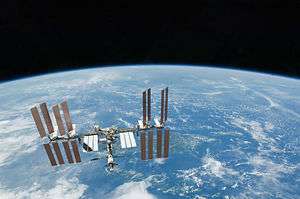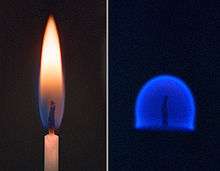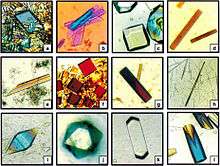Micro-g environment

The term micro-g environment (also µg, often referred to by the term microgravity) is more or less a synonym of weightlessness and zero-g, but indicates that g-forces are not quite zero, just very small.[1] The symbol for microgravity, µg, was used on the insignias of Space Shuttle flights STS-87 and STS-107, because these flights were devoted to microgravity research in low Earth orbit.
Absence of gravity
A "stationary" micro-g environment[2] would require travelling far enough into deep space so as to reduce the effect of gravity by attenuation to almost zero. This is the simplest in conception, but requires traveling an enormous distance, rendering it most impractical. For example, to reduce the gravity of the Earth by a factor of one million, one needs to be at a distance of 6 million km from the Earth, but to reduce the gravity of the Sun to this amount one has to be at a distance of 3.7 billion km. (The gravity due to the rest of the Milky Way is already smaller than one millionth of the gravity on Earth, so we do not need to move away further from its center). Thus it is not impossible, but it has only been achieved so far by four interstellar probes (Voyager 1 and 2, part of the Voyager program, Pioneer 10 and 11 part of the Pioneer program) and they did not return to Earth. To reduce the gravity to one thousandth of that on Earth's surface, one needs to be at a distance of 200,000 km.
| Location | Gravity due to | Total | ||
|---|---|---|---|---|
| Earth | Sun | rest of Milky Way | ||
| Earth's surface | 9.81 m/s2 | 6 mm/s2 | 200 pm/s2 = 6 mm/s/yr | 9.81 m/s2 |
| Low Earth orbit | 9 m/s2 | 6 mm/s2 | 200 pm/s2 | 9 m/s2 |
| 200,000 km from Earth | 10 mm/s2 | 6 mm/s2 | 200 pm/s2 | up to 12 mm/s2 |
| 6 million km from Earth | 10 μm/s2 | 6 mm/s2 | 200 pm/s2 | 6 mm/s2 |
| 3.7 billion km from Earth | 29 pm/s2 | 10 μm/s2 | 200 pm/s2 | 10 μm/s2 |
| Voyager 1 (17 billion km from Earth) | 1 pm/s2 | 500 nm/s2 | 200 pm/s2 | 500 nm/s2 |
| 0.1 light-year from Earth | 400 am/s2 | 200 pm/s2 | 200 pm/s2 | up to 400 pm/s2 |
At a distance relatively close to Earth (less than 3000 km), gravity is only slightly reduced. As an object orbits a body such as the Earth, gravity is still attracting objects towards the Earth and the object is accelerated downward at almost 1g. Because the objects are typically moving laterally with respect to the surface at such immense speeds, the object will not lose altitude because of the curvature of the Earth. When viewed from an orbiting observer, other close objects in space appear to be floating because everything is being pulled towards Earth at the same speed, but also moving forward as the Earth's surface 'falls' away below. All these objects are in free fall, not zero gravity.
Compare the gravitational potential at some of these locations.
Free fall
What remains is a micro-g environment moving in free fall, i.e. there are no forces other than gravity acting on the people or objects in this environment. To prevent air drag making the free fall less perfect, objects and people can free-fall in a capsule that itself, while not necessarily in free fall, is accelerated as in free fall. This can be done by applying a force to compensate for air drag. Alternatively free fall can be carried out in space, or in a vacuum tower or shaft.
The two cases that can be distinguished are that where the situation is only temporary because after some time the Earth's surface is or would be reached, and the case where the situation can go on indefinitely.
A temporary micro-g environment exists in a drop tube (in a tower or shaft), a sub-orbital spaceflight, e.g. with a sounding rocket, and in an airplane such as used by NASA's Reduced Gravity Research Program, aka the Vomit Comet, and by the Zero Gravity Corporation. A temporary micro-g environment is applied for training of astronauts, for some experiments, for filming movies, and for recreational purposes.
A micro-g environment for an indefinite time, while also possible in a spaceship going to infinity in a parabolic or hyperbolic orbit, is most practical in an Earth orbit. This is the environment commonly experienced in the International Space Station, Space Shuttle, etc. While this scenario is the most suitable for scientific experimentation and commercial exploitation, it is still quite expensive to operate in, mostly due to launch costs.
Tidal and inertial acceleration
Objects in orbit are not perfectly weightless due to several effects:
- Effects depending on relative position in the spacecraft:
- Because the force of gravity decreases with distance, objects which have a non-zero size will be subjected to a tidal force, or a differential pull, between the ends of the object nearest and furthest from the Earth. (An extreme version of this effect is spaghettification.) At Low Earth orbit (LEO) altitudes, the force differential is approximately 0.33 μg/m.
- In a spacecraft in LEO, the centrifugal force is greater on the side of the spacecraft furthest from the Earth. This is also a tidal force, adding 0.17 μg/m to the first-mentioned effect.
- "Floating" objects in a spacecraft in LEO are actually in independent orbits around the Earth. If two objects are placed side-by-side (relative to their direction of motion) they will be orbiting the Earth in different orbital planes. Since all orbital planes pass through the center of the earth, any two orbital planes intersect along a line. Therefore, two objects placed side-by-side (at any distance apart) will come together after one quarter of a revolution. If they are placed so they miss each other, they will oscillate past each other, with the same period as the orbit. This corresponds to an inward acceleration of 0.17 μg per meter horizontal distance from the center. If they are placed one ahead of the other in the same orbital plane, they will maintain their separation. If they are placed one above the other (at different radii from the center of the earth) they will have different potential energies, so the size, eccentricity, and period of their orbits will be different, causing them to move in a complex looping pattern relative to each other.[3]
- Gravity between the spacecraft and an object within it may make the object slowly "fall" toward a more massive part of it. The acceleration is 0.007 μg for 1000 kg at 1 m distance.
- Uniform effects (which could be compensated):
- Though very thin, there is some air at orbital altitudes of 185 to 1,000 km. This atmosphere causes deceleration due to friction. This could be compensated by a small continuous thrust, but in practice the deceleration is only compensated from time to time, so the small g-force of this effect is not eliminated.
- The effects of the solar wind and radiation pressure are similar, but directed away from the Sun. Unlike the effect of the atmosphere it does not reduce with altitude.
Commercial applications
Metal spheres
In a shot tower (now obsolete), molten metal (such as lead or steel), was dripped through a sieve into free fall. With sufficient height (several hundred feet), the metal would be solid enough to resist impact (usually in a water bath) at the bottom of the tower. While the shot may have been slightly deformed by its passage through the air and by impact at the bottom, this method produced metal spheres of sufficient roundness to be used directly in shotgun shells or to be refined by further processing for applications requiring higher accuracy.
High-quality crystals
While not yet a commercial application, there has been interest in growing crystals in micro-g, as in a space station or automated artificial satellite, in an attempt to reduce crystal lattice defects.[4] Such defect-free crystals may prove useful for certain microelectronic applications and also to produce crystals for subsequent X-ray crystallography.
 Comparison of boiling of water under earth's gravity (1 g, left) and microgravity (right). The source of heat is in the lower part of the photograph.
Comparison of boiling of water under earth's gravity (1 g, left) and microgravity (right). The source of heat is in the lower part of the photograph.

 Comparison of insulin crystals growth in outer space (left) and on Earth (right).
Comparison of insulin crystals growth in outer space (left) and on Earth (right).
See also
- μFluids@Home — a distributed computing project that models the behavior of liquid rocket propellants in micro-g
- Weightlessness
- European Low Gravity Research Association
References
- ↑ "Space myths and misconceptions – space flight". OMNI. 15 (7): 38ff. May 1993.
- ↑ Depending on distance, "stationary" is meant relative to Earth or the Sun.
- ↑ Chandler, David (May 1991). "Weightlessness and Microgravity" (PDF). The Physics Teacher: 312–13.
- ↑ "Growing Crystals in Zero-Gravity" News Article by Discovery
- ↑ Koszelak, S; Leja, C; McPherson, A (1996). "Crystallization of biological macromolecules from flash frozen samples on the Russian Space Station Mir". Biotechnology and Bioengineering. 52 (4): 449–58. doi:10.1002/(SICI)1097-0290(19961120)52:4<449::AID-BIT1>3.0.CO;2-P. PMID 11541085.
External links
| Wikimedia Commons has media related to |
- Overview of microgravity applications and methods
- Criticism of the terms "Zero Gravity" and "Microgravity", a persuasion to use terminology that reflects accurate physics (Sci.space post).
- Space Biology Research at AU-KBC Research Centre
- Microgravity alters cancer growth and progression